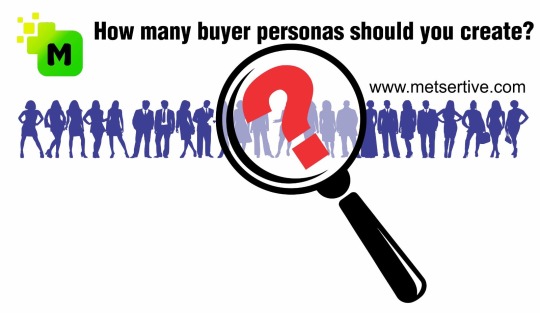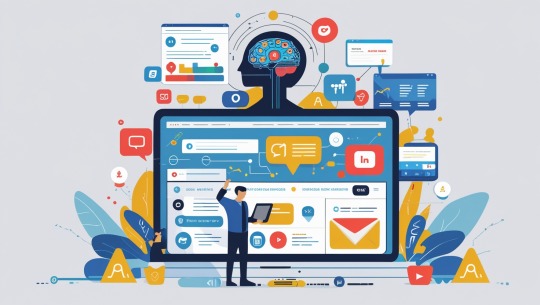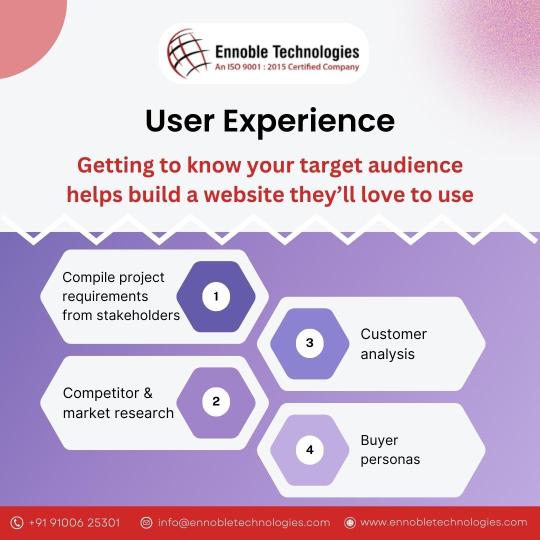#buyer personas
Explore tagged Tumblr posts
Photo

How many buyer personas should you create?
Creating more than one buyer persona can be helpful when you are trying to understand different segments of the market. This can help you to better understand your target market, and to make more informed decisions when developing your product or service. If the final consumer needs the approval of few others then each person involved in the decision to buy your goods/services is a different persona. You'll need different approaches to meet those objectives because they'll evaluate your goods/service using different standards.
4 notes
·
View notes
Text
Customer Persona: Taylor Trendsetter
• Name: Taylor Trendsetter
• Age: 26
• Occupation: Digital Marketing Specialist at a creative agency
• Location: Urban center (e.g., Brooklyn, New York)
Background & Lifestyle:
Taylor is a young professional with a bachelor’s degree in communications. Living in a bustling urban area, she is always in tune with the latest trends in technology, fashion, and design. Taylor is highly active on social media platforms like Instagram, TikTok, and Pinterest, where she both follows influencers and shares her own creative content. In her free time, she enjoys attending pop-up events, art exhibits, and local markets.
Interests & Behaviors:
• Passionate about technology and design, always looking for unique ways to express her personality.
• Enjoys personalizing everyday items to stand out from the crowd.
• Regularly seeks out local businesses that offer innovative and customized products.
• Follows trends and is influenced by social media influencers and digital marketing content.
• Values sustainability and authenticity in the brands she supports.
Goals & Motivations:
• Self-Expression: Taylor wants her accessories to reflect her unique style and creative spirit. She believes that personalized items are an extension of her identity.
• Quality & Uniqueness: She is willing to invest in products that offer high quality and originality rather than settling for mass-produced alternatives.
• Convenience: With a busy work and social schedule, she values services that are accessible—whether online or through mobile pop-up events that fit her lifestyle.
Challenges & Pain Points:
• Frustration with generic, mass-produced phone accessories that do not offer personalization or a sense of individuality.
• Limited availability of affordable, high-quality custom products in local markets.
• Inconsistent quality or design options from other brands that fail to match her creative expectations.
Buying Triggers:
• A compelling brand story that emphasizes creativity, innovation, and local engagement.
• A user-friendly customization process that allows her to design products that truly represent her style (e.g., adding a favorite quote, custom artwork, or a trendy design).
• Strong social media presence and positive reviews from influencers and peers.
• Competitive pricing paired with high-quality materials and craftsmanship.
How CustomTech Creations Meets Taylor’s Needs:
CustomTech Creations offers a mobile service that brings personalized phone accessories directly to local events, markets, and retail collaborations—exactly where Taylor lives and socializes. The business provides a seamless, interactive customization experience with a wide range of design options. With an emphasis on quality, creativity, and customer engagement, CustomTech Creations ensures that Taylor receives a product that not only meets her functional needs but also resonates with her personal brand.

1 note
·
View note
Text
The Role of Buyer Personas in B2B Market Research
When doing market research, it is absolutely important that your research chooses the right sample. Especially when your business is B2B. This helps to narrow down your focus and only target companies and buyers who reflect the qualities and mindsets of your model audience.
0 notes
Text
How Can You Create a Winning Online Marketing Plan?

Creating a successful online marketing plan starts with clear goals. What do you want to achieve? Define measurable objectives, like increasing website traffic by 20% in three months. Goals give direction and help track progress. For instance, an online clothing store may aim to boost sales during holiday seasons. Ensure your goals align with your overall business vision.
Next, understand your audience deeply. Research who they are, where they spend time online, and their preferences. Use surveys, social media insights, and website analytics. For example, a skincare brand targeting young adults might focus on Instagram and TikTok. Create buyer personas to guide your strategy. Knowing your audience ensures your efforts resonate and build connections.
Content is the heart of a strong marketing plan. Create valuable, engaging, and relevant material. This can include blogs, videos, social media posts, and emails. For instance, a travel agency can write blogs about hidden destinations or share exciting travel tips on YouTube. Use SEO strategies to ensure your content ranks well on search engines. Quality content attracts traffic and builds trust.
Don’t forget the power of social media. Choose platforms that align with your audience. Post regularly and engage with your followers. For example, a fitness brand can share workout routines or success stories on Instagram. Run paid campaigns to target specific demographics. Social media is great for building brand awareness and driving leads.
Finally, track your progress and adapt. Use tools like Google Analytics and social media metrics to measure performance. If a strategy isn’t working, adjust it. For example, if email campaigns have low open rates, test new subject lines or designs. A winning marketing plan evolves with time. Stay flexible and focus on providing value to your audience. This ensures long-term success online.
Discover BizMapUSA: Your Comprehensive Source for USA Contact Information
For in-depth access to extensive USA contact details, explore the BizMapUSA directory. Offering a wide array of listings, this resource ensures you can find specific contacts across various industries and regions within the United States. Whether you're searching for business contacts, customer service numbers, or professional connections, BizMapUSA is a dependable platform to streamline your search. Utilize its user friendly interface and vast database to access the most relevant and current contact information tailored to your needs. Efficiently uncover detailed American business contact information with the BizMapUSA directory today.
#Online Marketing Plan#Digital Marketing Strategy#Goal Setting for Marketing#Audience Research#Buyer Personas#Content Marketing Strategy#SEO Content Creation#Social Media Marketing#Social Media Engagement#Tracking Marketing Performance
0 notes
Text
Building an Ideal Customer Profile: Best Practices for B2B Marketers
Ideal Customer Profile (ICP) is one of the most impactful strategies in B2B marketing. It helps marketers and sales teams target their efforts more effectively, leading to better lead generation, improved ROI, and a streamlined sales process. But what exactly is an ICP, and how can B2B marketers build one that drives real results?
This comprehensive guide explores the components of an ICP, its significance in B2B marketing, and actionable steps to create one.
What is an Ideal Customer Profile (ICP)?
An Ideal Customer Profile (ICP) is a detailed description of the type of company that would benefit most from your product or service. It’s not about individual personas but about businesses as a whole.
Get full insights@ https://itechseries.com/blog/what-is-an-ideal-customer-profile/
For B2B marketers, the ICP includes attributes like industry, company size, annual revenue, location, and challenges. By defining your ICP, you focus your marketing and sales efforts on the accounts most likely to convert and stay loyal.
Why is an ICP Crucial for B2B Marketing?
In the crowded B2B market, not every lead is worth pursuing. An ICP helps you prioritize high-value accounts that align with your product or service, maximizing efficiency and outcomes.

Moreover, ICPs help align sales and marketing teams. Both teams can focus on the same target accounts, reducing friction and ensuring a consistent message throughout the buyer's journey.
Key Elements of an Ideal Customer Profile
To create an effective ICP, include the following key elements:
Firmographics: Define the company’s size, industry, revenue, and location.
Pain Points: Understand the challenges the company faces that your product or service can solve.
Buying Behavior: Analyze how similar companies have purchased in the past.
Goals and Needs: Identify what the company aims to achieve and how your offering aligns with those goals.
These elements help create a clear, actionable picture of your ideal customers.
The Role of ICP in Lead Generation
Lead generation becomes more efficient when you target the right accounts. With an ICP, you can focus on prospects who are more likely to convert, saving time and resources.
For example, if your ICP highlights that your ideal customers are mid-sized tech companies facing scaling challenges, you can tailor your campaigns specifically to address their needs. This targeted approach yields higher-quality leads and accelerates the sales pipeline.
How ICP Aligns Sales and Marketing Teams
Sales and marketing alignment is a common challenge in B2B organizations. An ICP serves as a unifying framework, ensuring that both teams are targeting the same high-value accounts.
When marketing generates leads based on the ICP, sales teams receive prospects that match their criteria. This alignment reduces wasted efforts and improves conversion rates, creating a more cohesive and efficient process.
Explore the latest marketing and tech insights@ https://itechseries.com/gtm-library/
Steps to Build an Ideal Customer Profile
Creating an ICP requires a mix of data analysis, collaboration, and strategic thinking. Here’s how to do it:
Analyze Existing Customers: Start by identifying your most successful customers. Look for commonalities in their firmographics, pain points, and buying behavior.
Conduct Market Research: Use surveys, interviews, and third-party data to gather insights about potential customers in your target market.
Collaborate Across Teams: Involve sales, marketing, and customer success teams to ensure the ICP reflects a 360-degree view of your ideal customer.
Refine and Iterate: Regularly update your ICP based on new data and feedback to keep it relevant and actionable.
How to Use ICP in Your B2B Marketing Strategy
Once you’ve defined your ICP, integrate it into your marketing strategy to optimize results.
Content Marketing: Create content that addresses the pain points and goals of your ICP. This could include blog posts, whitepapers, or case studies.
Targeted Campaigns: Use your ICP to guide ad targeting, ensuring your campaigns reach the most relevant audience.
Personalization: Tailor your messaging and offers to resonate with your ICP, increasing engagement and conversions.
Measuring the Success of Your ICP
An ICP isn’t a static document; it’s a living framework that evolves with your business. To ensure its effectiveness, measure its impact on key metrics like lead generation, conversion rates, and customer retention.
Use tools like CRM software and marketing analytics platforms to track how well your ICP is driving results. Regularly review this data and refine your profile as needed to stay aligned with your goals.
Conclusion
An Ideal Customer Profile is more than a marketing tool; it’s a strategic asset that drives alignment, efficiency, and growth in B2B marketing. By understanding your ideal customer and tailoring your efforts accordingly, you can maximize your impact and outpace the competition.
#Ideal Customer Profile#B2B Marketing#B2B Sales#Account Based Marketing#Sales and Marketing#Lead Generation#Business Growth#Buyer Personas
0 notes
Text
What to do When Your Friends and Family Don't Shop with You
It can be frustrating when your friends and family aren’t the best customers for your small business or store. The people you think are going to support you the most aren’t the ones spending the most money with you. And this is okay, it’s time to learn who your target market actually is. Friends and family mean well, but are not your ideal customer. “I have got to get into your store!” or “I’ve…
0 notes
Text

Famous Marketing Blunders that Everyone can Avoid
Although the best teacher is always experience. There is a lot we can learn about how to organize and expand our businesses from the experience of others. While we frequently concentrate on reading about the achievements of leaders in many fields and professions to achieve this. It may be just as beneficial to look at their errors and discover what not to do.
0 notes
Text

Getting to know your target audience helps us build a website they’ll love to use.
Adding insight to the design process with user research means you get a website that not only looks great, but also functions in a way that engages your target audience and encourages conversions.
Do Visit: https://ennobletechnologies.com/user-experience/
#userexperience#User#Experience#UX Research#Analysis#market research#Customer analysis#Buyer personas#ennoble technologies
1 note
·
View note
Text
The Four Practitioner Personas Every Service Provider Should Know
What are the four practitioner personas?
Video Summary: Jon Hansen and Bill DeMartino discuss the importance of being a customer-first solution provider and the different approaches to implementing change in organizations. They identify four personas, including those focused on immediate action, gradual improvements, process changes, and mid-market solutions. The conversation emphasizes solving problems rather than just building…

View On WordPress
0 notes
Text
"A veces el viaje más largo es la distancia entre dos personas".
"El velo pintado", William Somerset Maugham
#amor#frases#frases en español#personas#escritos#tumblr#frase en espa?ol#poem#buyer personas#poems on tumblr#frase en español#frases de amor#citas de amor#love poem
1 note
·
View note
Text
Mastering the Demand Generation Funnel: A Step-by-Step Guide to Creating and Optimizing Your Own for Maximum ROI
how to create a demand generation funnel that consistently brings in qualified leads and converts them into paying customers. Discover the key components of a successful funnel and best practices for optimization. Demand Generation Funnel: How to Create and Optimize Your Own for Maximum Results As a marketer, you know that generating demand is crucial for driving revenue and growing your…
View On WordPress
#Buyer Personas#Demand Generation Funnel#Funnel Optimization#Lead Generation#Marketing Strategy#Sales Strategy
0 notes
Text
7 crucial steps to analyze whether your Product is “MARKET FIT”
Market Fit analysis is a critical process in determining whether a SaaS product is suitable for the market. The following are the steps that can be taken to perform a market fit analysis of a SaaS product:
Identify the target market: Determine the specific group of people or businesses that the SaaS product is designed for. This includes understanding the demographics, psychographics, and other characteristics of the target market.
Analyze the competition: Determine the key competitors in the market and identify their strengths and weaknesses. This helps to understand what the market is looking for and what gaps can be filled by the SaaS product.
Analyze the market size and growth potential: Determine the size of the market (TAM) and its growth potential. This helps to determine the revenue potential and the opportunity for the SaaS product.
Conduct customer interviews: Conduct interviews/VoC campaigns with potential customers to understand their needs, pain points, and what they are looking for in a SaaS product. This helps to identify if the SaaS product is a fit for the market.
Determine pricing strategy: Determine the pricing strategy based on the competition, market size, and the value provided by the SaaS product. This helps to ensure that the SaaS product is priced competitively and provides value to customers.
Test the product: Test the SaaS product with potential customers (Beta Testing) to identify any issues or areas for improvement. This helps to ensure that the SaaS product meets the needs of the market.
Iterate and improve: Based on the feedback received from customers, iterate and improve the SaaS product to ensure that it meets the needs of the market.
By following these steps, a SaaS product can be evaluated for market fit and improved to meet the needs of the market.
0 notes
Text
ANYONE ANIME NORTH ATENDEES DOWN TO BUY ME SOMETHING AT ARTIST ALLEY?
HELLO!! I am interested in an item that can only be purchased in-person at Anime North in Toronto, Canada...but unfortunately I'm stuck 3,500 miles away in Hawaii. 💔
One of the artists selling this zine is naro (@naroym_ on Twitter) and I believe they'll be at table #444 (right side blurred due to possibly disturbing imagery). It's the "Adachi risograph zine"

I'd pay for the price of the zine, shipping, and a little extra for your troubles (maybe $10-20?? or I'll buy YOU a copy if you're also an Adachi fan lol) via PayPal.
The zine itself is ~$25 USD. I'm not entirely sure if they'll have it out on their table, so please consider asking the artist/whomever is running the booth for a copy just in case it's a special "if you're in the know" situation.
Ideally you'd buy it, I reimburse you (within 24 hours), then we discuss shipping shortly after the convention is over. When everything is packed/ready to go, I pay for the shipping and then you drop that bad boy off at the post office!!
Please sandwich the book between thick cardboard/chipboard when shipping. I really don't want it to get bent on the way here.
I have good standing as a seller and buyer on Mercari and eBay (I'm not sure why this matters to some people but it does. I can and will pay you back asap.)
PLEASE LET ME KNOW IF YOU'RE DOWN. >:,J
#anime north#anime north 2024#personal shopper#persona 4#persona#tohru adachi#proxy shipping#proxy buyer#in-person shopper#irl stuff
13 notes
·
View notes
Text
Why Brand Building is Essential for Brand to Demand Success?
In the dynamic world of B2B marketing, standing out requires more than just generating leads or pushing products. Today’s top brands recognize that effective Brand Building is foundational to Brand to Demand success. Bridging the gap between creating an enduring brand identity and generating demand is not just beneficial but essential for long-term growth. This blog explores why brand building is crucial for demand success and how a strong brand fuels growth, credibility, and customer loyalty.
What is Brand Building, and Why is it Vital?
Brand building is the process of creating a distinct identity for your business. It’s about developing a brand that reflects your values, purpose, and promise to customers. This process is foundational to any business because it establishes a unique identity and sets the stage for meaningful customer relationships.
Get full insights@ https://itechseries.com/blog/brand-building-for-demand-success/
How Does Brand Building Lead to Demand Generation?
Brand building and demand generation are closely intertwined. While demand generation focuses on creating interest and nurturing leads, brand building sets the foundation for that interest. Essentially, a well-established brand makes it easier to generate demand because customers are already familiar with the value proposition and have a level of trust in the brand.

When customers recognize a brand and associate it with reliability, they are more inclined to explore its offerings, creating a cycle where brand reputation fuels demand. For example, a brand that consistently showcases its expertise in B2B technology solutions will be top-of-mind when businesses seek such solutions. This top-of-mind awareness is a powerful driver for demand generation.
What Are the Core Components of an Effective Brand to Demand Strategy?
An effective Brand to Demand strategy combines several components that build trust while driving lead generation. Here are the key elements to consider:
Audience-Centric Messaging: Crafting a message that speaks directly to your target audience is essential. The goal is to align your brand’s purpose with the needs and values of your audience, creating a seamless connection between brand and demand.
Consistent Brand Voice: Consistency is crucial in Brand to Demand success. A consistent voice and message across channels establish reliability and professionalism, both key drivers in building a trustworthy brand.
High-Quality Content: Content is at the heart of brand building and demand generation. By producing thought leadership pieces, case studies, and white papers, you not only showcase expertise but also demonstrate value, which attracts potential clients and fosters brand loyalty.
Data-Driven Targeting: Using data to segment and target audiences ensures that the right message reaches the right person at the right time. This alignment is critical in converting brand awareness into demand.
Engagement Channels: Engaging with prospects and customers on the platforms they frequent allows you to build relationships and deliver value, which supports brand loyalty and demand generation.
By integrating these elements into a Brand to Demand strategy, companies create a cohesive approach that builds trust, drives engagement, and ultimately fuels demand.
How Does Brand to Demand Impact Customer Loyalty?
Brand building is not just about attracting new customers; it’s also essential for retaining existing ones. Customer loyalty is strengthened when a brand consistently delivers on its promise. When customers trust a brand, they’re more likely to remain loyal, engage with it over time, and even refer others.
Brand to Demand also fosters loyalty by creating a customer experience that feels connected to the brand’s mission and values. For instance, a B2B software provider known for innovation and customer support will retain clients who value those qualities. This loyalty, in turn, leads to demand, as satisfied customers advocate for the brand, resulting in organic demand generation through referrals.
Explore the latest marketing and tech insights@ https://itechseries.com/gtm-library/
What Role Does Content Play in Brand Building?
Content is a powerful tool in Brand to Demand strategies because it creates value at every stage of the customer journey. Through blogs, case studies, and white papers, content not only educates and engages audiences but also reinforces a brand’s expertise and value.
Effective content forges connections between brand and customer. When customers find solutions to their problems or gain insights through branded content, they build a positive association with the brand. This, in turn, drives demand because clients are more likely to engage with a brand they trust and view as a thought leader.
For example, a company that regularly publishes articles on B2B marketing trends builds credibility and becomes a go-to source for information. When those same readers are ready to invest in a service, they’ll think of that brand first. In this way, content becomes a bridge between brand building and demand generation.
What Are the Key Metrics to Track in Brand to Demand Strategies?
To evaluate the effectiveness of Brand to Demand efforts, companies should focus on metrics that measure both brand awareness and demand generation. Here are a few key metrics to track:
Brand Awareness: Measure how recognizable your brand is within the target market through metrics like social media reach, website traffic, and content engagement.
Lead Quality and Conversion Rates: Track the quality of leads generated and how often these leads convert into customers.
Customer Lifetime Value (CLV): Understand the value of long-term customer relationships, which are often built through effective brand building.
Customer Retention Rate: High retention rates indicate successful brand building, as customers continue to engage with and trust the brand.
Customer Referrals: Track how many new clients are coming from referrals, which is a strong indicator of brand loyalty and demand generation.
By monitoring these metrics, companies can refine their Brand to Demand strategies, optimizing their efforts to achieve sustainable growth.
Get your business boost, visit now@ https://itechseries.com/contact-us/
Conclusion
For companies aiming for long-term growth, bridging the gap between brand building and demand generation is a strategic priority. A well-established brand lays the groundwork for demand, creating a cycle where customer trust fuels interest and engagement. Brand to Demand strategies are essential not only for short-term lead generation but for creating a brand that resonates with customers over the long haul.
0 notes
Text



Customer Buyer Persona Research
My inspiration/research into other Customer buyer Personas. I found this useful to give me ideas on what I needed to include in my own.


Creating my own Customer Personas
As a starting point I asked my housemate (who studies Photography) if she had any portraits I could use as my customers. She did and after gainig their permission I was able to start creating my personas from these photos which helped me start visualising them as real people. I edited my photos according to the giffgaff design guidelines - they stated that they use black and white photos with a grainy effect so I edited my photos on photoshop accordingly. They also like to use a white outline around the photo and remove the back ground so I included that too; to make the white line more prominent, I drew some textured paint backgrounds on my ipad to use as a minor detail that incorporated the giffgaff primary colours.
3 notes
·
View notes
Text
Famous Marketing Blunders that Everyone can Avoid
Although the best teacher is always experience. There is a lot we can learn about how to organize and expand our businesses from the experience of others. While we frequently concentrate on reading about the achievements of leaders in many fields and professions to achieve this. It may be just as beneficial to look at their errors and discover what not to do.
0 notes